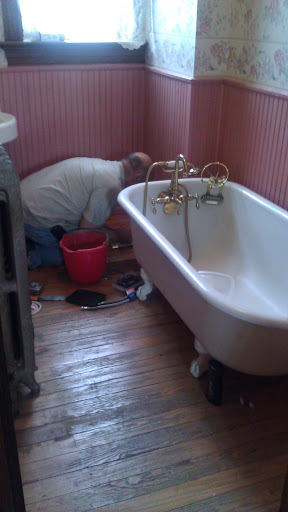I had to ask whether they (“they” meaning, at least, the wealthy) had indoor plumbing in 1908. After all, we looked at another St. Charles house built maybe 10 years before this one, and in one corner of the decrepit “garage” there was an old outhouse. It turns out that
they certainly did… but it was not common. According to one source, “In 1921, only 1% of homes in the US had indoor plumbing.” It is plausible to me that it would be your bigger, more expensive homes (like ones with servant stairs) that might have been among that lucky 1% — but, of course, the municipal infrastructure would also have to be available in their location, I assume.
In any case, I was told that our 2nd floor bathroom (aka, the “pink bathroom”) is likely original to the house:

It would not have been pink, of course. Paint was all oil-based at that time, and therefore very expensive. That’s largely why often everything – EVERYTHING – was wallpapered… even closets… even the ceiling. And wallpaper patterns were usually either drab or garish. (We definitely will not be restoring every aspect of this house to the original style…!) In any case, I am wondering whether the pink wainscoting would have been white, or even just wood with varnish (in keeping with the preponderance of woodwork throughout the rest of the house). We may have to strip some of that pink paint and see what the wood looks like beneath.
As we aren’t in the house yet (only 1 week to go!), I cannot get a better photograph than the above, which was actually taken by the appraiser. But based on that photo, I’ve been told that the sink is probably original. Notice the separate hot & cold taps. Also, that pedestal base you see beneath it (which is in that awkward position because someone moved it out to get a look at the plumbing), would not have been there. Either the bare pipes would have been left visible (hmm, perhaps people were still sufficiently impressed by indoor plumbing that they liked to look at the pipes?), or they would have put a fabric skirt around them, beneath the sink.
The toilet may also be original (again, need a better angle), as may the bath tub. The tub is a clawfoot tub, although upon my scant appraisal I thought the clawed feet looked rather rough and under-detailed. I’ve been told, however, that usually antique clawfoot tubs are found covered in layers upon layers of paint – this would certainly explain the rather crude look of the feet. That’s just one more thing I cannot wait to examine more closely next week. As well, the hardware on the bath tub, apparently, would be quite expensive even if it’s newer, and particularly valuable if it is original. As one sage on the Old House Web put it, “With hardware like that, your tub deserves nice feet.” We shall see!
I will post again once we can examine this room up close. Also, I will update you on the results of my latest inquiry to my wonderfully helpful contact at the Association of Historic Frenchtown; I’ve asked for her opinion on how old the bathroom is, and whether indoor plumbing was available in St. Charles in the early 1900s.
In the mean time, enlighten yourself on the history of plumbing. I, ahem, shit you not – an Englishman named
Thomas Crapper had a hand in early toilet development in the late 1800s (although he did not, despite rumors to the contrary, invent the toilet).
In 1885, a revolution in toilet making occurred: Thomas Twyford created the first valveless toilet made of china. Until then, water closets were more commonly made of metal and wood…
Up until the 1800s in the US, most water pipes were made of hollowed trees. Cast iron pipe imported from England had one of its first installations in Bethlehem, Pennsylvania. By the early 1800s, cast iron production began domestically in New Jersey. In 1848, the National Public Health Act was passed creating a plumbing code for the US.
Almost simultaneously in 1883, both the Standard Sanitary Manufacturing Company (now American Standard) and Kohler began the process of enameling cast iron bathtubs to form a smooth interior surface. Kohler's first clawfoot tub was advertised as a "horse trough/hog scalder, when furnished with four legs will serve as a bathtub. " These tubs soon became mass-produced as they were recognized as having an extremely sanitary surface that was easy to clean, thus preventing the spread of bacteria and diseases…
The end of World War I brought with it a construction boom in the US. Bathrooms were fitted with a toilet, sink, and bathtub - mostly clawfoot bathtubs. But even in 1921, only one percent of homes in the US had indoor plumbing. Outhouses were still the norm in rural America. The Sears catalog, with its uncoated, absorbent pages, was a popular form of toilet paper often found hanging inside the outhouse.
Quoted from
http://www.homeimprovementweb.com/information/clawfoot-tub-history.htmAnd a much longer, more thorough article on the subject can be found at
ThePlumber.com. It is interesting to see a number of very familiar names, like American Standard, Kohler, and Moen, dating back to (and influencing) the advent of indoor plumbing in the late 1800s.






















